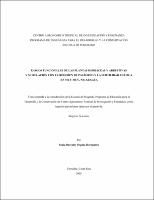| dc.contributor.advisor | Ibrahim, Muhammad | |
| dc.contributor.author | Ospina Hernández, S.D. | |
| dc.date.accessioned | 2014-10-17T15:44:21Z | |
| dc.date.available | 2014-10-17T15:44:21Z | |
| dc.date.issued | 2005 | es_ES |
| dc.identifier | 366938 | es_ES |
| dc.identifier.uri | https://repositorio.catie.ac.cr/handle/11554/2286 | |
| dc.description | Tesis (M. Sc) -- CATIE, Turrialba (Costa Rica), 2005 | es_ES |
| dc.description | 88 páginas | |
| dc.description | 10 ilus. 17 tab. | |
| dc.description | Bib. p. 71-81 | |
| dc.description.abstract | Los objetivos específicos fueron: i) relacionar regímenes de pastoreo, condiciones de fertilidad edáfica y estación climática sobre la composición y diversidad de especies y ii) evaluar la distribución de rasgos funcionales de las plantas asociados con la respuesta a la herbivoría. Se estudiaron tres tipos de pastizales: en baja fertilidad pastoreados por ganado en Producción, o por ganado horro y en alta fertilidad pastoreados por ganado en Producción. Los contrastes fueron dos condiciones de fertilidad edáfica, dos regímenes de pastoreo y dos estaciones climáticas. Con cargas animales bajas y pastoreo estacional intenso, las plantas mostraton estrategias para la persistencia y competencia por recursos del suelo, pero el valor forrajero del pastizal se redujo por la alta abundancia de especies anuales. La tolerancia y la resistencia fueron estrategias de defensa al pastoreo, que introdujeron cambios en la composición de los pastizales, sin embargo, estos cambios también fueron afectados por el manejo de la intensidad de pastoreo, las decisiones de los productores y por la interacción con la estacionalidad climática. | es_ES |
| dc.description.abstract | Specific objectives were: i) to relate grazing regimens, soil fertility conditions and climatic season on the species composition and diversity and ii) to evaluate plant functional traits distribution associated with the herbivory response. Three grassland types were studied: in low fertility grazing by milking cow, or by dry cow in high fertility grazing by milking cow. Two soil fertility conditions, two grazing regimens and two climatic season were contrasted. With low stocking rate and intensive seasonal grazing, the plants showed strategies to the persistence and competence by soil resources, but the forage value of grassland was reduced by the high abundance of annual species. The tolerance and resistance were defense strategies to the grazing that introduced shifts in the grassland composition, although those shifts also were affected by grazing intensity management, the producers decisions and by the interaction with climatic seasonality. | |
| dc.language.iso | es | es_ES |
| dc.publisher | Centro Agronómico Tropical de Investigación y Enseñanza (CATIE) | es_ES |
| dc.subject | SHRUBS | |
| dc.subject | HERBACEOUS PLANTS | |
| dc.subject | PASTURES | |
| dc.subject | GRAZING | |
| dc.subject | GRASSLAND MANAGEMENT | |
| dc.subject | GRAZING SYSTEMS | |
| dc.subject | SOIL FERTILITY | |
| dc.subject | CLIMATIC FACTORSARBUSTOS | |
| dc.subject | PLANTAS HERBACEAS | |
| dc.subject | PASTIZALES | |
| dc.subject | PASTOREO | |
| dc.subject | MANEJO DE PRADERAS | |
| dc.subject | SISTEMAS DE PASTOREO | |
| dc.subject | FERTILIDAD DEL SUELO | |
| dc.subject | FACTORES CLIMATICOS | |
| dc.subject | NICARAGUA | |
| dc.title | Rasgos funcionales de las plantas herbáceas y arbustivas y su relación con el régimen de pastoreo y la fertilidad edáfica en Muy Muy, Nicaragua | es_ES |
| dc.title.alternative | Herbaceous and woody plant functional traits and its relation with the grazing regimen and the soil fertility in Muy Muy, Nicaragua | es_ES |
| dc.type | Tesis de maestría | es_ES |
| dc.identifier.publication | Turrialba (Costa Rica) | es_ES |


